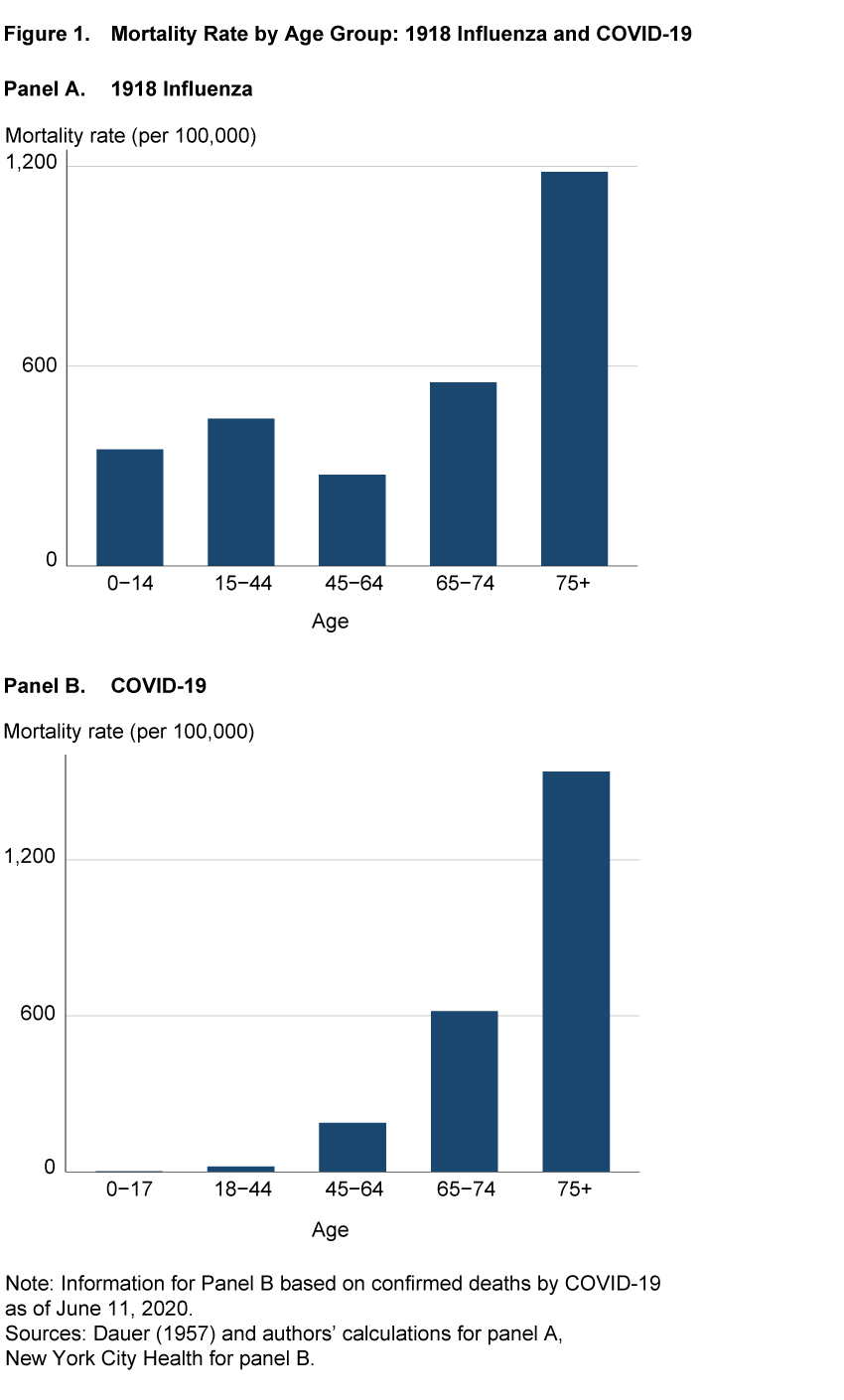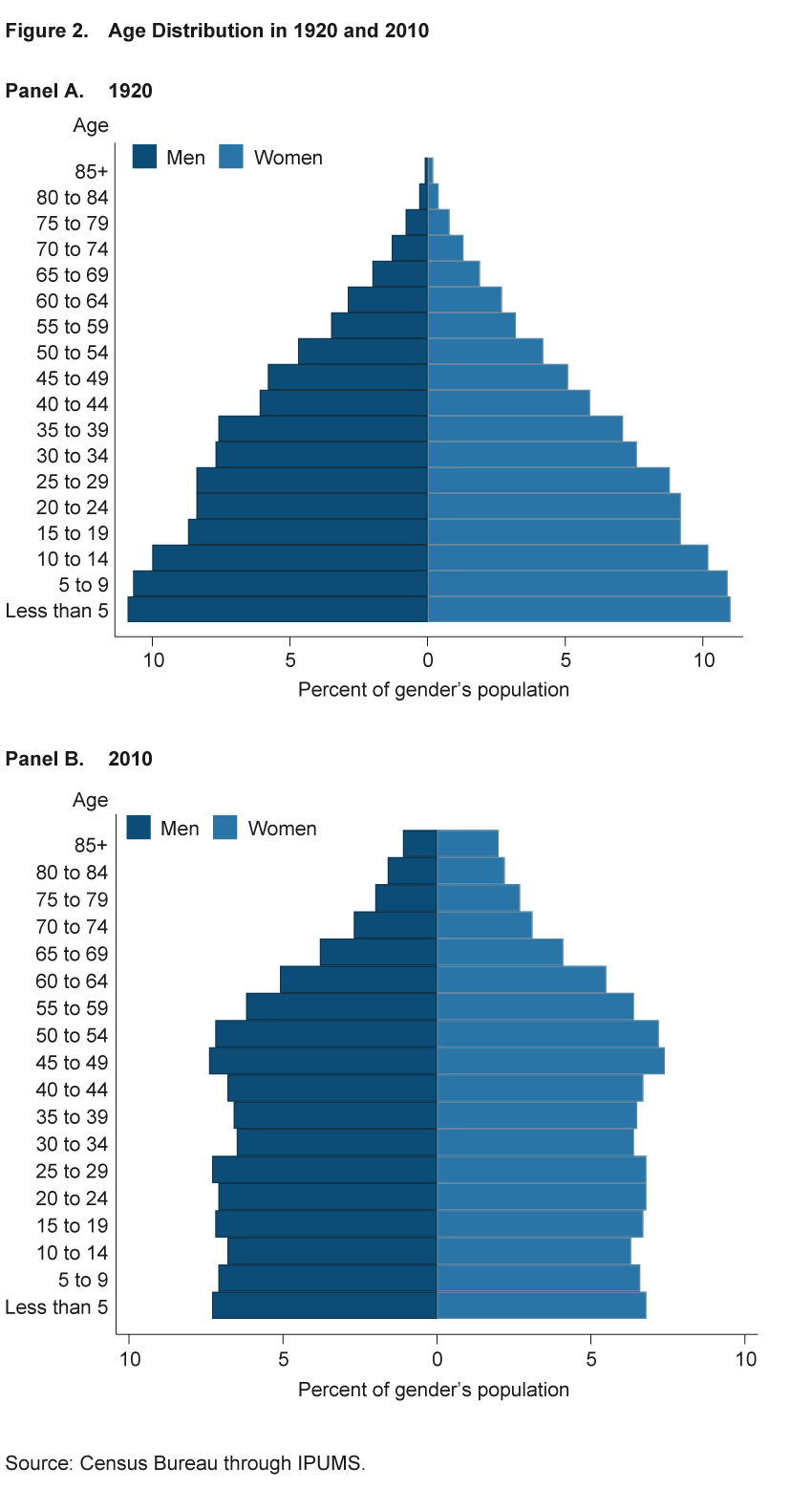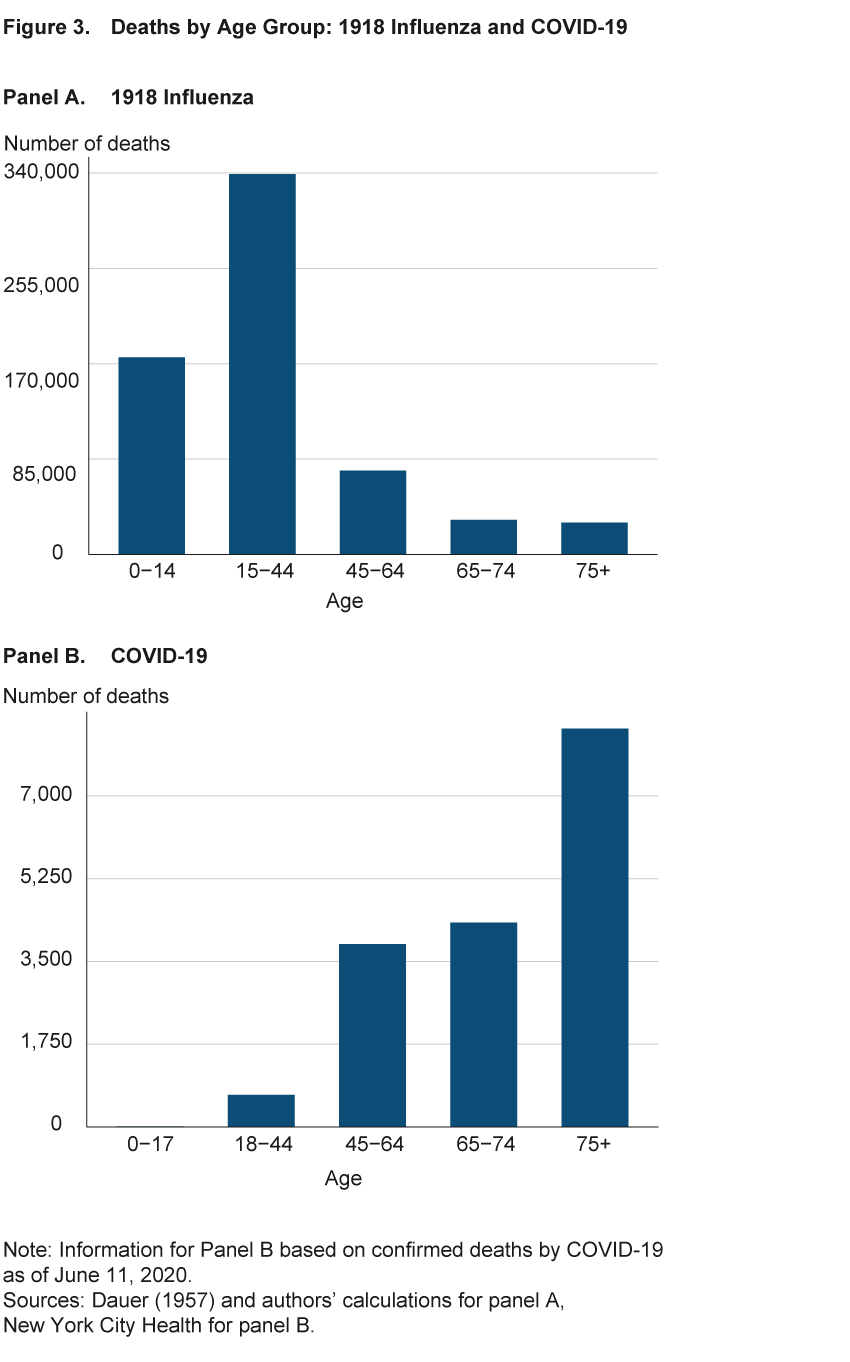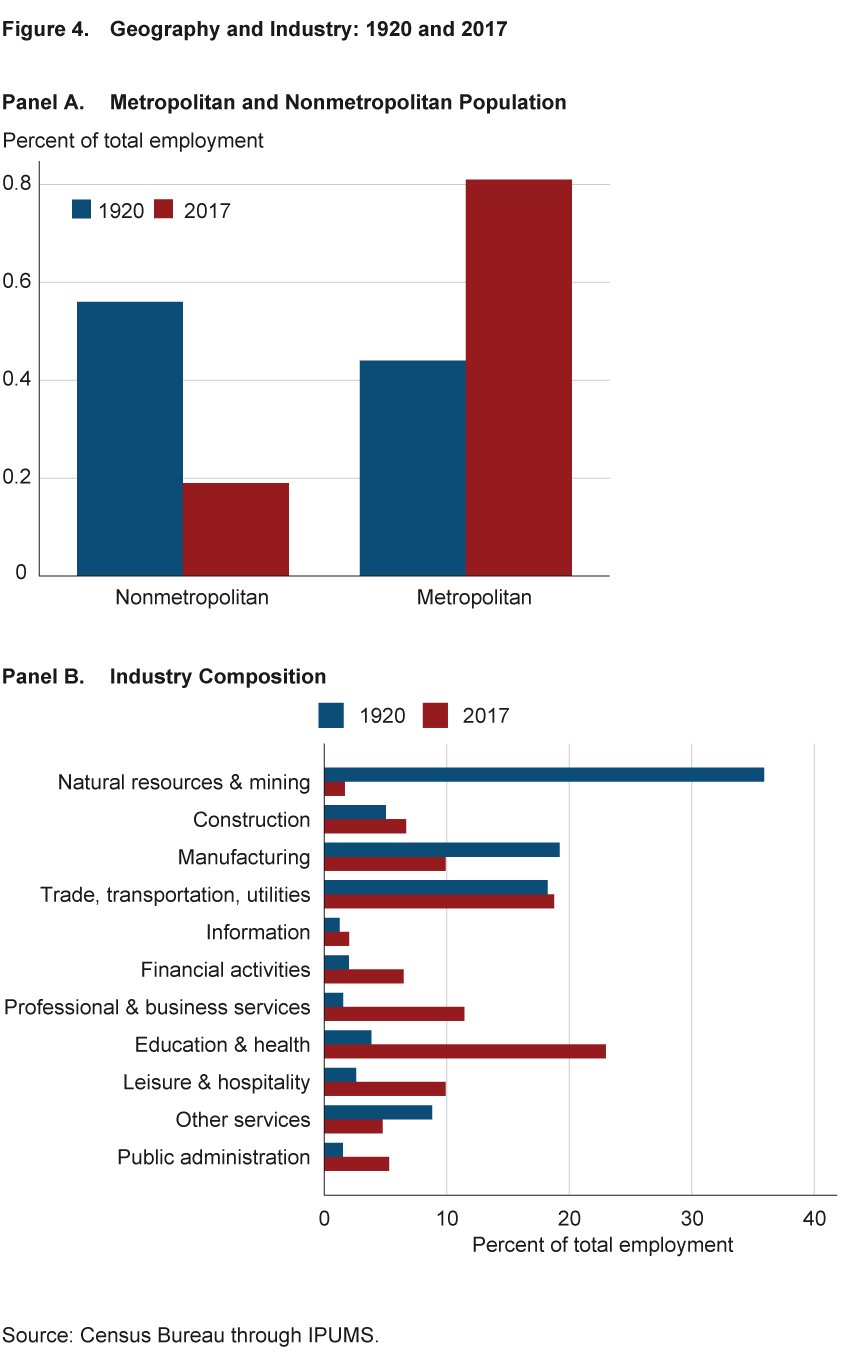- Share
The 1918 Flu and COVID-19 Pandemics: Different Patients, Different Economy
Many observers seeking historical precedent for COVID-19 draw on the 1918 influenza pandemic. In this Commentary, we highlight the differences between the 1918 flu and COVID-19 pandemics in terms of the most significantly affected populations. We also show key differences in the US economy in the late 1910s and now. Not only did the 1918 influenza virus primarily affect significantly younger cohorts, but the US economy’s industry and geographic distributions were notably different at the time compared to today’s. Consequently, caution is needed when using the 1918 influenza pandemic as a guideline for implementing and evaluating policy responses to COVID-19.
The views authors express in Economic Commentary are theirs and not necessarily those of the Federal Reserve Bank of Cleveland or the Board of Governors of the Federal Reserve System. The series editor is Tasia Hane. This paper and its data are subject to revision; please visit clevelandfed.org for updates.
While COVID-19 presents an exceptional challenge to our country, this is not the first time the United States has confronted a highly contagious virus or resultant disease. Notably, variants of the influenza virus have risen to pandemic levels on several occasions, including H2N2 in 1957 and, more recently, H1N1 in 2009. Yet even at its peak, no recent outbreak has spread and overwhelmed the healthcare system in the way COVID-19 has. For that reason, many researchers and policymakers are turning to the 1918 influenza pandemic—which killed an estimated 50 million people worldwide and more than 1 in 200 Americans—as a source of information for crafting a suitable response to the medical and economic challenges imposed by COVID-19 (see Correia, Luck, and Verner, 2020; and Barro, Ursúa, and Weng, 2020; among others).
Although there are some parallels, both in the number of countries affected and in the measures implemented by certain US states to control the spread of the disease, there are also stark distinctions. For one, the demographics of the most significantly affected populations differ greatly between the two pandemics. Additionally, the structure of the economy has changed since 1918, affecting how people interact and where they live. Such differences make using the 1918 influenza pandemic a potentially problematic choice for projecting the economic impact of COVID-19 or the likely effectiveness of measures adopted to curtail the spread of the virus. Considering the contrasts between the two pandemics, researchers and policymakers should exercise caution when extrapolating the economic outcomes from the 1918 flu to the current environment.
The 1918 Flu versus COVID-19: Profile of Likely Victims
The first major difference between the 1918 influenza and COVID-19 pandemics is visible in the profiles of likely victims. The 1918 flu had a much higher mortality rate among infants and people in their prime working ages than has been the case for COVID-19 (compare figure 1 panels A and B).
Consequently, a larger share of the population was vulnerable to fatal infection during the 1918 pandemic because populations tend to skew younger, and this was particularly true around the time of the 1918 flu (see figure 2).1


The combined effects of a larger mortality rate among younger age groups with a much younger overall population in 1918 implied a noticeably younger skew in the age profile of victims. As we can see in panel A of figure 3, the majority of deaths from the 1918 flu occurred among people ages 15 to 44.2 Meanwhile, although deaths from COVID-19 do occur in people of all ages, they have been most concentrated among the elderly: Panel B of figure 33 shows that the vast majority of COVID-19’s victims in New York City are more than 75 years old and therefore not as likely to be a current part of the country’s active workforce.

This difference in the age distribution of casualties may lead to different economic outcomes between the two pandemics. Garrett (2009) shows that states and cities that had greater mortality from the 1918 influenza virus experienced higher wage growth in manufacturing between 1914 and 1919—roughly 23 percentage points for a 10 percent higher per capita mortality—an effect attributable to the decrease in the size of the labor pool. Moreover, the loss of a significant share of the prime-age labor force can have a significant negative impact on output and productivity growth (Cuddington and Hancock, 1993). It is unlikely that we will see these effects for COVID-19 since mortality is far lower among the working-age population. As a result, using the 1918 influenza pandemic to project the economic impact of COVID-19 may result in a significant overestimation of the long-run impact of the disease.
Structure of the Economy: Then and Now
Another factor that makes the 1918 flu pandemic a problematic parallel for the current COVID-19 pandemic is the structure of the US economy. It differs drastically now from what it was at the time of the flu 100 years ago. Notably, even after a decade of mass transition from rural to urban dwelling, the country was still significantly more rural in 1918 than it is in 2020. More than half of the working-age population lived in nonmetropolitan areas in 1920, compared to 19 percent now (figure 4). The larger rural population of that time meant that most areas were less densely populated, a circumstance that helped limit the spread of the 1918 flu. As Garrett (2007, table 4) shows, cities had a higher per capita mortality rate than rural areas in the same state, demonstrating a positive correlation between population density and influenza-related mortality.

The less intense spread of the influenza virus in nonmetropolitan areas served to partially mitigate the economic impact of the 1918 pandemic. Employment in 1920 was concentrated in natural resources and mining, and jobs in this sector were overwhelmingly located in nonmetropolitan areas with lower population density. Indeed, Basco, Domènech, and Rosés (2020) find little decline in production in the agriculture sector as a result of the 1918 flu. In contrast, in 2017,4 only 1.7 percent of prime-age workers were in the natural resources and mining sectors (compared to 35.9 percent in 1920).5 The situation today, with more densely populated urban areas, could allow COVID-19 to spread faster than it would have in 1918 and cause greater economic harm. Similarly, measures designed to contain the virus are more likely to target denser areas and impede their economic activity.
Among the sectors whose populations have grown as a share of the labor force since 1920, some, such as healthcare, are deemed essential and maintain high rates of employment despite the inherent risks. And others, such as professional services, are mostly able to conduct operations remotely, an opportunity that was far less available in the early twentieth century. However, today’s economy also has a much larger share of the labor force in sectors that are neither deemed essential nor able to telework, such as leisure and hospitality, which employed close to 10 percent of the labor force in 2017, compared to 2.6 percent in 1920. Workers in these sectors are vulnerable to the impacts of the partial economic shutdowns accompanying state and municipal stay-at-home orders: millions have lost their jobs as a result. We contend that these differences in where employment is concentrated—in terms of both geography and industry—have allowed COVID-19 to exact a greater toll on the labor market than it would have in 1918. Had the employment concentrations of today more closely resembled those of 1918, the vast disemployment that has accompanied the virus would likely have been less pronounced.
Finally, the historic period in which the 1918 pandemic unfolded presents another sharp contrast to COVID-19. Because of the impact of World War I, despite the mass casualties inflicted by the 1918 flu, the resulting economic contraction proved relatively minor (see Velde, 2020; and Benmelech and Frydman, 2020). The demand generated by the war effort boosted economic recovery in ways for which there is no parallel in today’s environment. This issue further advises against an analysis comparing economic aggregates between 1918 and 2020.
Conclusion
In this Commentary, we contrast the characteristics of the populations affected by the 1918 flu and COVID-19 pandemics, along with the underlying geographic and industry characteristics of the US economy in these two time periods. We argue that many of the trends relating to the 1918 flu—including increased wages among the working-age population and the limited disemployment—are direct reflections of the age profile of victims and the structure of the US economy at the time. Neither the most significantly affected age groups nor the makeup of the economy is similar between the two pandemics, a situation that makes comparisons between the two problematic.
Our goal is not to invalidate analyses that use the 1918 flu and its effects to draw conclusions about the expected patterns for COVID-19, but instead to give some context that may help to interpret the results and select the more suitable assumptions for comparisons. In particular, comparing nationwide indicators between the two periods is ill-advised because of the differences in the economic structure and macroeconomic conditions across the two time periods. However, even analyses that focus on areas whose features more closely resemble those of today’s economy (major cities in 1918, for example) still have to confront the substantially different profile of likely victims and the divergent economic effects that come with it. As a result, analysis using the 1918 experience must make adjustments to account for the distinct features of each pandemic.
Footnotes
- We present male and female age pyramids for both 1920 and 2010 instead of a joint distribution for two reasons. First, in 1920 women’s labor force participation was quite low, so focusing on a joint distribution could be potentially misleading. Second, men’s age pyramid in 1920 potentially could be significantly different from women’s because of the impact of World War I. Return
- The age distribution of the mortality rate resulting from the 1918 flu is often described as “W-shaped.” The most vulnerable groups were infants and the elderly. There was also a significant spike and drop in the mortality rate from ages 10 to 45. Return
- See: https://www1.nyc.gov/site/doh/covid/covid-19-data.page. Return
- Information for 2017 is based on the American Community Survey for the years 2016 to 2018 in order to increase sample size, following standard procedures in the literature. Return
- Roughly 96 percent of agricultural workers lived in rural areas in 1920. Return
References
- Barro, Robert J., José F. Ursúa, and Joanna Weng. 2020. “The Coronavirus and the Great Influenza Pandemic: Lessons from the ‘Spanish Flu’ for the Coronavirus’s Potential Effects on Mortality and Economic Activity.” National Bureau of Economic Research, Working Paper No. 26866. https://doi.org/10.3386/w26866.
- Basco, Sergi, Jordi Domènech, and Joan R. Rosés. 2020. “The Redistributive Effects of Pandemics: Evidence on the Spanish Flu.” Universidad Carlos III de Madrid, Working Papers in Economic History, No. 2020-05.
- Benmelech, Efraim, and Carola Frydman. 2020. “The 1918 Influenza Did Not Kill the US Economy.” VOX CEPR Policy Portal. https://voxeu.org/article/1918-influenza-did-not-kill-us-economy.
- Correia, Sergio, Stephan Luck, and Emil Verner. 2020. “Pandemics Depress the Economy, Public Health Interventions Do Not: Evidence from the 1918 Flu.” Available at SSRN. https://doi.org/10.2139/ssrn.3561560.
- Cuddington, John T., and John D. Hancock. 1994. “Assessing the Impact of AIDS on the Growth Path of the Malawian Economy.” Journal of Development Economics, 43(2): 363–368. https://doi.org/10.1016/0304-3878(94)90013-2.
- Dauer, Carl C. 1957. The Pandemic of Influenza in 1918–19. Washington DC: Public Health Service, National Office of Vital Statistics.
- Garrett, Thomas A. 2007. “Economic Effects of the 1918 Influenza Pandemic.” Federal Reserve Bank of St. Louis, report. https://www.stlouisfed.org/~/media/files/pdfs/community-development/research-reports/pandemic_flu_report.pdf.
- Garrett, Thomas A. 2009. “War and Pestilence as Labor Market Shocks: US Manufacturing Wage Growth 1914–1919.” Economic Inquiry, 47(4): 711–725. https://doi.org/10.1111/j.1465-7295.2008.00137.x.
- Velde, François. 2020. “What Happened to the US Economy during the 1918 Influenza Pandemic? A View through High-frequency Data.” Federal Reserve Bank of Chicago, Working Paper, No. 2020-11 (revised April 2020). https://www.chicagofed.org/publications/working-papers/2020/2020-11.
Suggested Citation
Cohen-Kristiansen, Ross, and Roberto B. Pinheiro. 2020. “The 1918 Flu and COVID-19 Pandemics: Different Patients, Different Economy.” Federal Reserve Bank of Cleveland, Economic Commentary 2020-13. https://doi.org/10.26509/frbc-ec-202013
This work by Federal Reserve Bank of Cleveland is licensed under Creative Commons Attribution-NonCommercial 4.0 International





